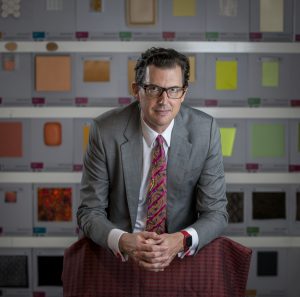Question #1 – Who is this?

My name is Richard Lombard, and I am (by no particular plan) a materials specialist. Which is to say that I am the most specialized generalist around.
I studied Russian as an undergraduate (and in Leningrad, when it was still named that), worked at an art museum, left to get my MBA (and succeeded – International Finance), decided I really didn’t like Finance and went to work for a medical foundation, then an auction house, and then a materials consultancy.
For six years, I taught at Virginia Commonwealth University in Qatar as an Assistant (and – upon my departure – Associate) Professor in the MFA.DESIGN program, and created and served as Curator of the Materials Library.
I left the Middle East (reluctantly) and have since been consulting with architects and designers on materially-related projects, while also teaching at institutions like Politecnico di Milano, Pratt Institute, and College for Creative Studies.
For more, gory details, see my LinkedIn profile, or my CV
Question #2 – What do you do?
My wife has been asking this for years . . .
Essentially, I am a connector of people and resources relevant to the world of design. (While I – miserably – failed Malcolm Gladwell’s test, I still maintain that I am pretty good at this.)
I advise designers and companies on material issues relevant to their products. This can happen anytime between the ideation phase, “How are we going to make this product flexible/sustainable/ lightweight/etc.?” and the production phase, “We need a material that is injection-moldable AND has great heat resistance.” As that aforementioned generalist, I have a wide view of the materials market, and like to cross-pollinate across industries.
I work with schools and educational institutions on the creation of materials resources, as well as the creation and delivery of curricular content. I have extensive experience in academic materials research, both in terms of digital database and physical resource construction.
I also create content of many kinds, from conference presentations and articles to conferences themselves. Materials have a place in virtually every topic and are a great way to make complicated ones very manageable. I once likened materials to the Rosetta Stone: they translate into every discipline of design, as well as every aspect of the manufacturing process. Design, economics, even global politics can be embodied and communicated within material issues.
This goes back to the connector bit: I am interested in a wide range of topics, and know a wide range of people who (I think) are interesting and are doing good work – and want these people and ideas to be heard.
Question #3 – Um, why the site?
I guess I am trying to do what anyone with a blog does – get his/her opinion out there, and hope that it resonates with someone somewhere. I like to put pieces together that both address historical context and current implications, so that they are a bit more than opinion pieces. As a result, I don’t post every day, but I try to get something up a couple times a
monthyear. I sometimes succeed.I do not track visitors to the site, and I don’t intend to do so. I am not doing this for the fame, despite all of the comments that tell me I could be making big money with my blog . . .
